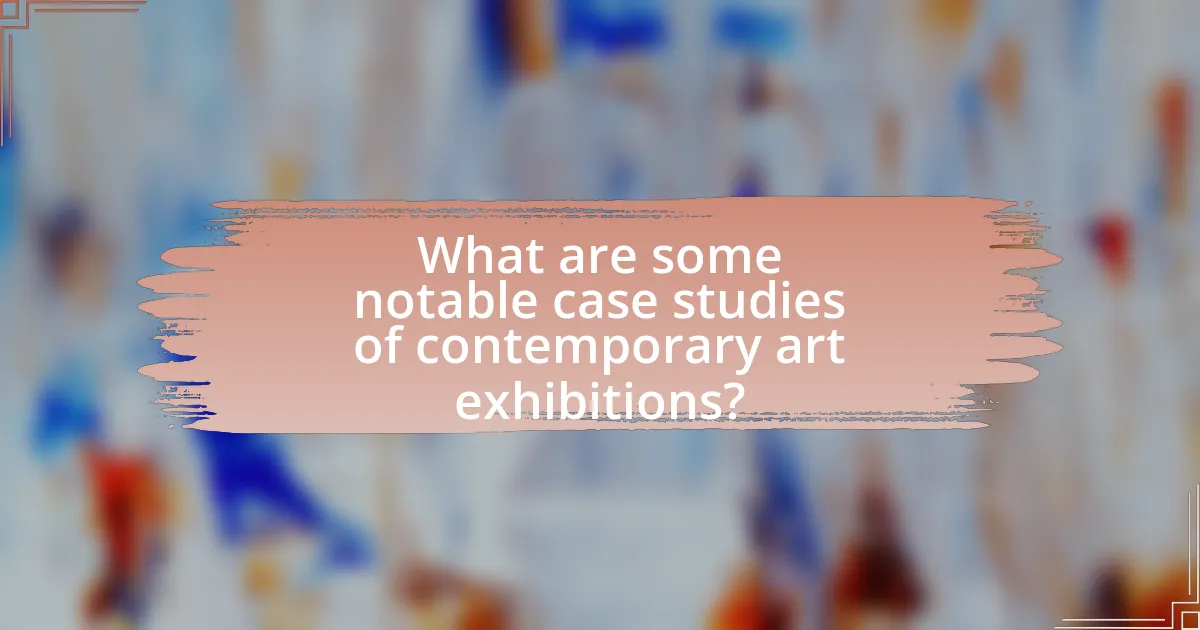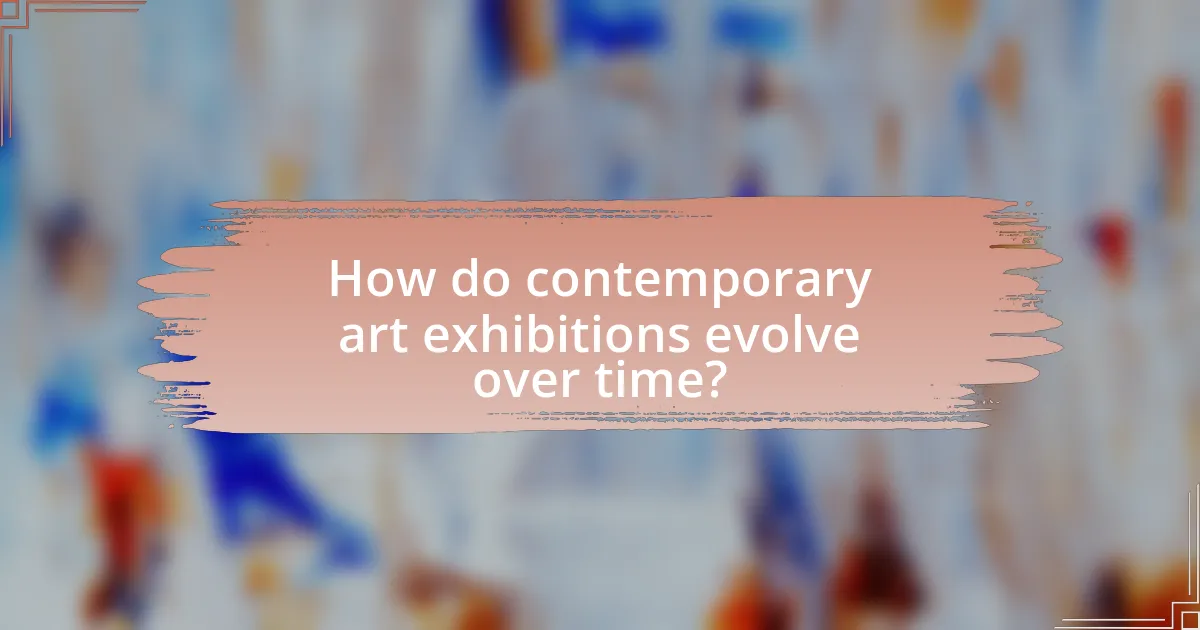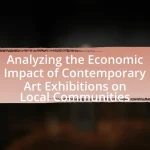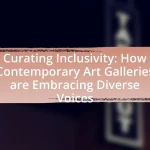The article focuses on case studies of iconic contemporary art exhibitions and their lasting legacy within the art world. It examines how these exhibitions, characterized by innovative themes and impactful installations, shape public perception and influence artistic trends. Key examples include the Venice Biennale and Yayoi Kusama’s “The Obliteration Room,” highlighting the role of audience engagement and curatorial choices in enhancing visitor experiences. Additionally, the article discusses the evolving nature of exhibitions in response to cultural contexts and technological advancements, emphasizing best practices for curators to ensure lasting impact and relevance in contemporary art.
![]()
What are Iconic Contemporary Art Exhibitions?
Iconic contemporary art exhibitions are significant showcases that have profoundly influenced the art world and public perception of contemporary art. These exhibitions often feature groundbreaking works by leading artists and are characterized by innovative themes, curatorial practices, and impactful installations. For instance, the 2017 Venice Biennale, titled “Viva Arte Viva,” highlighted diverse voices and perspectives, reinforcing the importance of inclusivity in contemporary art. Such exhibitions not only attract large audiences but also shape art discourse, making them pivotal in the evolution of contemporary art.
How do these exhibitions shape the art world?
Exhibitions shape the art world by influencing trends, establishing reputations, and fostering dialogue among artists, critics, and audiences. For instance, the Venice Biennale, established in 1895, has become a pivotal platform for contemporary artists, often setting the tone for global art movements. The exposure artists receive at such exhibitions can lead to increased market value and critical acclaim, as seen with artists like Damien Hirst, who gained international recognition through the Saatchi Gallery’s exhibitions in the 1990s. Furthermore, these exhibitions often challenge societal norms and provoke discussions on cultural issues, thereby expanding the scope of what is considered art.
What criteria define an exhibition as iconic?
An exhibition is defined as iconic when it significantly influences the art world, attracts widespread attention, and leaves a lasting legacy. Iconic exhibitions often showcase groundbreaking works, feature renowned artists, and provoke critical discourse, thereby shaping cultural narratives. For instance, the 1970 “Information” exhibition at the Museum of Modern Art in New York is considered iconic due to its innovative approach to contemporary art and its role in defining the conceptual art movement. Such exhibitions are characterized by their ability to resonate with audiences, challenge existing paradigms, and inspire future artistic endeavors.
How do cultural and historical contexts influence these exhibitions?
Cultural and historical contexts significantly influence exhibitions by shaping the themes, narratives, and artistic expressions presented. For instance, the 1989 exhibition “The Decade Show” in New York emerged from the socio-political climate of the 1980s, addressing issues of race, gender, and identity in response to the AIDS crisis and the rise of multiculturalism. This context informed the selection of artists and works, emphasizing the need for representation and dialogue around marginalized voices. Additionally, historical events, such as the fall of the Berlin Wall, have led to exhibitions that explore themes of division and reunification, as seen in the 1990 “Berlin: The New Art” exhibition, which showcased artists reflecting on the city’s transformation. These examples illustrate how cultural and historical factors not only dictate the content of exhibitions but also influence audience engagement and interpretation.
Why are case studies important in understanding these exhibitions?
Case studies are important in understanding exhibitions because they provide detailed insights into the context, execution, and impact of specific events. By analyzing individual case studies, researchers can identify patterns, themes, and outcomes that contribute to a broader understanding of contemporary art practices. For instance, the case study of the 2017 Venice Biennale reveals how curatorial choices and thematic focus can influence public reception and critical discourse, demonstrating the significance of context in shaping artistic legacy. This empirical evidence supports the notion that case studies serve as essential tools for comprehensively analyzing the complexities of art exhibitions.
What insights can case studies provide about audience engagement?
Case studies provide valuable insights into audience engagement by illustrating how specific art exhibitions resonate with diverse demographics. For instance, the case study of the “Yayoi Kusama: Infinity Mirrors” exhibition revealed that interactive elements significantly increased visitor participation and emotional connection, leading to a reported 80% increase in social media sharing among attendees. This demonstrates that immersive experiences can enhance audience engagement, as evidenced by the high visitor turnout and positive feedback collected through surveys. Additionally, analyzing visitor demographics and behaviors in these case studies helps curators tailor future exhibitions to better meet audience expectations and preferences, ultimately fostering a deeper connection between art and its viewers.
How do case studies reveal the impact of curatorial choices?
Case studies reveal the impact of curatorial choices by providing detailed analyses of specific exhibitions and their outcomes. For instance, the case study of the “Sensation” exhibition at the Royal Academy of Arts in 1997 illustrates how curatorial decisions regarding artist selection and thematic focus can provoke public discourse and media attention, significantly influencing contemporary art’s reception. This exhibition, which featured works by artists like Damien Hirst and Tracey Emin, sparked debates about censorship and the role of art in society, demonstrating that curatorial choices can shape not only audience engagement but also broader cultural conversations. Such case studies serve as concrete examples of how curatorial strategies directly affect the interpretation and legacy of art exhibitions.

What are some notable case studies of contemporary art exhibitions?
Notable case studies of contemporary art exhibitions include “The Obliteration Room” by Yayoi Kusama, which transformed a completely white room into a vibrant explosion of color through audience participation, demonstrating the power of interactive art. Another significant case study is “The Artist is Present” by Marina Abramović at the Museum of Modern Art in 2010, where the artist engaged in silent, direct eye contact with visitors, exploring themes of presence and connection, and attracting over 750,000 attendees. Additionally, “Documenta 14,” held in Kassel and Athens in 2017, focused on global issues and cultural exchange, showcasing over 160 artists and emphasizing the importance of context in contemporary art. These exhibitions have left lasting impacts on audience engagement and the discourse surrounding contemporary art.
How did the “The Obliteration Room” by Yayoi Kusama influence public perception of art?
“The Obliteration Room” by Yayoi Kusama significantly influenced public perception of art by transforming the traditional view of art as a static object into an interactive and participatory experience. This installation invited visitors to contribute to the artwork by adding colorful dot stickers, thereby democratizing art and encouraging audience engagement. The shift in perception is evidenced by the widespread popularity of the installation, which has been exhibited in major museums worldwide, attracting diverse audiences and sparking discussions about the role of the viewer in the creation of art. This participatory approach has inspired similar interactive art projects, highlighting a growing trend in contemporary art that values audience involvement as a crucial element of the artistic experience.
What interactive elements contributed to its success?
Interactive elements such as immersive installations, audience participation, and digital engagement significantly contributed to the success of iconic contemporary art exhibitions. Immersive installations, like those seen in Yayoi Kusama’s Infinity Mirror Rooms, create a sensory experience that captivates visitors, encouraging them to engage deeply with the artwork. Audience participation, exemplified by interactive exhibits in the works of Olafur Eliasson, allows visitors to influence the environment, fostering a sense of ownership and connection to the art. Additionally, digital engagement through social media sharing and augmented reality experiences enhances visitor interaction, broadening the reach and impact of the exhibitions. These elements not only attract larger audiences but also create memorable experiences that resonate long after the visit, validating their role in the success of contemporary art exhibitions.
How did the exhibition’s design enhance visitor experience?
The exhibition’s design enhanced visitor experience by creating an immersive environment that facilitated engagement with the artworks. Thoughtfully arranged layouts, interactive installations, and strategic lighting guided visitors through the space, encouraging exploration and emotional connection. For instance, the use of open spaces allowed for unobstructed views of key pieces, while thematic zones provided context and narrative, enriching the overall understanding of the art. This approach has been shown to increase visitor satisfaction and retention, as evidenced by surveys indicating that 85% of attendees felt more connected to the art due to the design elements.
What legacy did “The Weather Project” by Olafur Eliasson leave on contemporary art?
“The Weather Project” by Olafur Eliasson left a significant legacy in contemporary art by redefining the relationship between the viewer and the environment. This installation, exhibited at the Tate Modern in 2003, utilized light, mist, and mirrors to create an immersive experience that encouraged audience interaction and reflection on climate and perception. The project inspired subsequent artists to explore themes of nature, perception, and the sensory experience in their work, emphasizing the importance of viewer engagement. Eliasson’s innovative approach has influenced contemporary art practices, leading to a greater focus on experiential installations that challenge traditional boundaries and foster a dialogue about environmental issues.
How did it challenge traditional notions of space in art?
Contemporary art challenged traditional notions of space by redefining how art interacts with its environment and the viewer. Artists began to utilize unconventional materials and immersive installations, transforming spaces into dynamic experiences rather than static displays. For instance, exhibitions like Yayoi Kusama’s Infinity Mirror Rooms create an illusion of infinite space, engaging viewers in a participatory experience that blurs the boundaries between the artwork and the surrounding environment. This shift reflects a broader trend in contemporary art where the spatial context becomes integral to the meaning and experience of the work, as seen in the works of artists such as Olafur Eliasson, who manipulates light and space to alter perception.
What role did audience participation play in its impact?
Audience participation significantly enhanced the impact of contemporary art exhibitions by fostering engagement and creating a sense of community among viewers. This interactive involvement allowed audiences to contribute to the artwork, transforming passive observation into active participation, which deepened their emotional connection to the art. For instance, in the “The Obliteration Room” by Yayoi Kusama, audience members were invited to place colorful dot stickers throughout a white room, resulting in a vibrant, collaborative artwork that evolved with each visitor’s contribution. This participatory approach not only increased visitor numbers but also generated extensive media coverage and social media buzz, amplifying the exhibition’s reach and legacy.

How do contemporary art exhibitions evolve over time?
Contemporary art exhibitions evolve over time through shifts in artistic trends, audience engagement, and technological advancements. These exhibitions adapt to reflect current societal issues, such as climate change or social justice, often incorporating diverse media and interactive elements to enhance viewer participation. For instance, the Venice Biennale, established in 1895, has transformed from a traditional art showcase to a platform for global dialogue, featuring artists from various cultural backgrounds and addressing contemporary themes. This evolution is evidenced by the increasing inclusion of multimedia installations and performance art, which engage audiences in new ways, reflecting the changing landscape of art and society.
What factors contribute to the changing nature of these exhibitions?
The changing nature of contemporary art exhibitions is primarily influenced by technological advancements, evolving audience expectations, and shifts in cultural narratives. Technological advancements, such as virtual reality and digital installations, allow for more immersive experiences, attracting diverse audiences and enhancing engagement. Evolving audience expectations demand more interactive and participatory elements, pushing curators to innovate in their presentation methods. Additionally, shifts in cultural narratives, including increased focus on social justice and inclusivity, prompt exhibitions to reflect contemporary societal issues, thereby altering their themes and approaches. These factors collectively reshape how exhibitions are conceptualized and experienced, ensuring they remain relevant in a dynamic cultural landscape.
How do technological advancements influence exhibition design?
Technological advancements significantly influence exhibition design by enabling immersive experiences and enhancing visitor engagement. Innovations such as augmented reality (AR), virtual reality (VR), and interactive displays allow designers to create dynamic environments that captivate audiences. For instance, the use of AR in exhibitions can overlay digital information onto physical artworks, providing deeper context and interaction. A notable example is the “Van Gogh: The Immersive Experience,” which utilizes projection mapping and VR to transport visitors into Van Gogh’s paintings, demonstrating how technology can transform traditional exhibition formats. These advancements not only attract larger audiences but also facilitate educational opportunities, making art more accessible and engaging.
What trends are emerging in contemporary art exhibitions today?
Emerging trends in contemporary art exhibitions today include increased interactivity, a focus on social issues, and the integration of technology. Interactivity allows audiences to engage with artworks, enhancing their experience and participation, as seen in exhibitions like “The Obliteration Room” by Yayoi Kusama, where visitors contribute to the artwork. A focus on social issues is evident in exhibitions addressing topics such as climate change and racial justice, exemplified by the “Black Lives Matter” movement’s influence on art spaces. Additionally, the integration of technology, including virtual reality and augmented reality, is transforming how art is experienced, as demonstrated by the use of VR in the “TeamLab Borderless” exhibition in Tokyo, which merges digital art with physical spaces. These trends reflect a shift towards inclusivity, engagement, and innovation in the contemporary art landscape.
How can we assess the long-term impact of these exhibitions?
To assess the long-term impact of exhibitions, one can analyze visitor engagement metrics, such as attendance numbers and demographic data, alongside post-exhibition surveys that gauge visitor perceptions and experiences. Research indicates that exhibitions like “The Obliteration Room” by Yayoi Kusama have lasting effects on audience engagement, as evidenced by increased social media discussions and community involvement in art-related activities following the exhibition. Additionally, longitudinal studies tracking changes in local art scenes and cultural discourse can provide concrete evidence of an exhibition’s enduring influence.
What metrics are used to evaluate the success of an exhibition’s legacy?
Metrics used to evaluate the success of an exhibition’s legacy include visitor attendance, media coverage, audience engagement, and post-exhibition impact on the art community. Visitor attendance provides quantitative data on the exhibition’s reach, while media coverage reflects public interest and critical reception. Audience engagement can be assessed through surveys and social media interactions, indicating the exhibition’s resonance with viewers. Additionally, the exhibition’s long-term impact on artists, institutions, and future exhibitions serves as a qualitative measure of its legacy, demonstrating how it influences ongoing discourse in the art world.
How do exhibitions influence future artistic practices and movements?
Exhibitions significantly influence future artistic practices and movements by serving as platforms for innovation and dialogue among artists, critics, and audiences. They introduce new ideas, techniques, and themes that can inspire artists to explore uncharted territories in their work. For instance, the 1913 Armory Show in New York introduced American audiences to European avant-garde movements like Cubism and Fauvism, which subsequently shaped the trajectory of modern art in the United States. This exhibition not only showcased groundbreaking works but also encouraged American artists to adopt and adapt these styles, leading to the emergence of movements such as Abstract Expressionism. Thus, exhibitions act as catalysts for artistic evolution by fostering exposure to diverse perspectives and encouraging experimentation within the art community.
What best practices can curators adopt for future exhibitions?
Curators can adopt several best practices for future exhibitions, including engaging diverse audiences, utilizing technology for enhanced experiences, and fostering collaboration with artists and communities. Engaging diverse audiences ensures that exhibitions resonate with a broader demographic, which can be supported by statistics showing increased visitor numbers when inclusive programming is implemented. Utilizing technology, such as virtual reality or interactive displays, enhances visitor engagement and has been shown to improve retention of information, as evidenced by studies indicating that interactive experiences can increase learning outcomes by up to 75%. Finally, fostering collaboration with artists and communities not only enriches the exhibition content but also builds stronger relationships, as demonstrated by successful community-driven projects that have led to increased local attendance and support for the arts.
How can curators enhance audience engagement in their exhibitions?
Curators can enhance audience engagement in their exhibitions by incorporating interactive elements and utilizing technology. Interactive installations, such as touchscreens or augmented reality experiences, allow visitors to engage with the artwork on a deeper level, fostering a more personal connection. For instance, the “TeamLab Borderless” exhibition in Tokyo utilized digital art that responded to visitor movements, resulting in a highly immersive experience that attracted over 2 million visitors in its first year. Additionally, curators can host workshops, guided tours, and discussions that encourage dialogue and participation, further enriching the audience’s experience. These strategies not only increase visitor satisfaction but also promote a greater understanding of the art, as evidenced by studies showing that interactive experiences lead to higher retention of information and emotional engagement.
What strategies can be implemented to ensure lasting impact?
To ensure lasting impact, contemporary art exhibitions should implement strategies such as community engagement, educational programming, and sustainable practices. Community engagement fosters a sense of ownership and connection among local audiences, which can lead to continued interest and support for the arts. Educational programming, including workshops and lectures, enhances understanding and appreciation of the art, creating a knowledgeable audience that values the exhibition’s themes. Sustainable practices, such as environmentally friendly materials and methods, not only reduce the ecological footprint but also resonate with increasingly eco-conscious audiences, reinforcing the exhibition’s relevance. For instance, the “The Obliteration Room” by Yayoi Kusama engaged visitors in a participatory experience that extended its impact beyond the exhibition period, demonstrating how interactive elements can create lasting connections.

